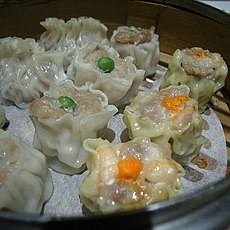Shumai
 |
|
| Alternative names | Variously spelt shaomai, shui mai, shu mai, sui mai, shui mei, siu mai, shao mai, siew mai, or siomai |
|---|---|
| Course | Dim sum |
| Place of origin | China |
| Region or state | Inner Mongolia |
| Main ingredients | seasoned ground pork, whole and chopped shrimp, Chinese black mushroom, lye water dough |
| Variations | Siomay |
| |
|
| Shumai | |||||||||||||||||||
| Chinese name | |||||||||||||||||||
|---|---|---|---|---|---|---|---|---|---|---|---|---|---|---|---|---|---|---|---|
| Traditional Chinese | |||||||||||||||||||
| Simplified Chinese | |||||||||||||||||||
| Literal meaning | to cook and sell | ||||||||||||||||||
|
|||||||||||||||||||
| Vietnamese name | |||||||||||||||||||
| Vietnamese | xíu mại | ||||||||||||||||||
| Thai name | |||||||||||||||||||
| Thai | ขนมจีบ [kʰā.nǒm.t͡ɕìːp] | ||||||||||||||||||
| RTGS | khanom chip | ||||||||||||||||||
| Japanese name | |||||||||||||||||||
| Kanji | 焼売 | ||||||||||||||||||
| Kana | シュウマイ | ||||||||||||||||||
|
|||||||||||||||||||
| Filipino name | |||||||||||||||||||
| Tagalog | siyomay | ||||||||||||||||||
| Hindi name | |||||||||||||||||||
| Hindi | पकौड़ी | ||||||||||||||||||
| Transcriptions | |
|---|---|
| Standard Mandarin | |
| Hanyu Pinyin | shāomài |
| Hakka | |
| Romanization | sehw mai |
| Yue: Cantonese | |
| Jyutping | siu1 maai6*2 |
| Southern Min | |
| Hokkien POJ | sio-māi |
| Transcriptions | |
|---|---|
| Romanization | shūmai |
Shaomai (simplified Chinese: 烧卖; traditional Chinese: 燒賣; pinyin: shāomài), Cantonese romanized as siu mai, is a type of traditional Chinese dumpling, originated from Hohhot, Inner Mongolia. In Cantonese cuisine, it is usually served as dim sum. Along with Chinese diaspora, variation of Shaomai also appears in Japan (焼売, Shumai) and Southeast Asia (Siomay).
In the Qing dynasty, the fillings varied by season: garlic chives in spring, mutton and pumpkin in summer, crab meat in autumn, and mixed seafood in winter.
Many varieties have been created as shumai was gradually introduced to all provinces, where it was adapted to the different regional tastes throughout China. However, most people in Western countries associate shumai with only the Cantonese version due to the Cantonese diaspora.
This is the most well-known variety from the south-eastern province of Guangdong. As prepared in Cantonese cuisine, siumai is also referred to as "pork and mushroom dumpling." Its standard filling consisting primarily of ground pork, small whole or chopped shrimp, Chinese black mushroom, green onion (also called scallion) and ginger with seasonings of Chinese rice wine e.g. Shaoxing rice wine, soy sauce, sesame oil and chicken stock. Bamboo shoots, water chestnuts and pepper can also be added. The outer covering is made of a thin sheet of lye water dough. The center is usually garnished with an orange dot, made of crab roe or diced carrot, although a green dot made with a pea may be used. The decorative presentations vary.
...
Wikipedia
